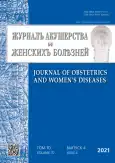Modern sonographic markers for the prognosis of preterm birth in women with different somatotypes
- Authors: Tomaeva K.G.1, Gaidukov S.N.2, Komissarova E.N.2, Tomaev G.G.3
-
Affiliations:
- North Ossetian State Medical Academy
- Saint Petersburg State Pediatric Medical University
- Limited liability company «Nikamed»
- Issue: Vol 70, No 4 (2021)
- Pages: 91-98
- Section: Original study articles
- URL: https://journals.rcsi.science/jowd/article/view/59053
- DOI: https://doi.org/10.17816/JOWD59053
- ID: 59053
Cite item
Abstract
BACKGROUND: Preterm birth is one of the causes of perinatal morbidity and mortality. Premature infants have an increased risk of death and the development of neurological and other disorders.
AIM: The aim of this study was to evaluate the modern sonographic parameters of the cervix in pregnant women with different somatotypes and to develop a mathematical model for predicting preterm birth.
MATERIALS AND METHODS: The study included 390 women, among whom 110 were classified with macrosomatic, 173 with mesosomatic, and 107 with microsomatic types. Somatotype was determined in women in early stages of pregnancy (before 9-10 weeks of gestation) using the R.N. Dorokhov anthropometric test method. The utero-cervical angle was measured, shear wave elastography was performed, and the average shear wave speed in the area of the internal cervical os was determined. All measurements were performed on a Philips EPIQ 5 ultrasound machine.
RESULTS: Preterm birth was more often identified in women with macro- and microsomatic types in comparison with women with mesosomatic type (p < 0.05). In pregnant women with subsequent preterm birth at 22-23 weeks, the average SWS in the area of the internal cervical os was reduced (p < 0.05) and the utero-cervical angle was higher in comparison with those women who did not have preterm birth (p < 0.05). Using multiple regression analysis, we obtained the regression equation (formula), which predicts the development of preterm birth in women with different somatotypes.
CONCLUSIONS: Such parameters as the average shear wave speed in the area of the internal cervical os and the utero-cervical angle may be regarded as markers of preterm birth. The mathematical formula obtained allows for predicting the development of preterm birth in women with different somatotypes and for timely prevention of pathology.
Keywords
Full Text
##article.viewOnOriginalSite##About the authors
Kristina G. Tomaeva
North Ossetian State Medical Academy
Email: tomaevakg@mail.ru
ORCID iD: 0000-0003-0269-5507
SPIN-code: 7129-6523
MD, Cand. Sci. (Med.), Assistant Professor, Department of Obstetrics and Gynecology № 2
Russian Federation, 9 Pushkinskaya Str., Vladikavkaz, 362019Sergey N. Gaidukov
Saint Petersburg State Pediatric Medical University
Email: gaiducovsn@yandex.ru
MD, Dr. Sci. (Med.), Professor, Department of Obstetrics and Gynecology
Russian Federation, 2 Litovskaya st., Saint-Petersburg, 194100Elena N. Komissarova
Saint Petersburg State Pediatric Medical University
Email: komissaren@yandex.ru
Dr. Sci. (Biol.), Professor, Department of Human Anatomy
Russian Federation, 2 Litovskaya st., Saint-Petersburg, 194100Georgii G. Tomaev
Limited liability company «Nikamed»
Author for correspondence.
Email: g.tomaeff@yandex.ru
ORCID iD: 0000-0002-2455-1283
MD, doctor-surgeon-orthopedist
Russian Federation, 14/2 Bumazhnyj proezd, Moscow, 127015References
- Crump C, Sundquist J, Sundquist K. Preterm delivery and long term mortality in women: national cohort and co-sibling study. BMJ. 2020;370:m2533. doi: 10.1136/bmj.m2533
- Huang J, Qian Y, Gao M, et al. Analysis of factors related to preterm birth: a retrospective study at Nanjing Maternity and Child Health Care Hospital in China. Medicine (Baltimore). 2020;99(28):e21172. doi: 10.1097/MD.0000000000021172
- Keag OE, Murphy L, Bradley A. Postal recruitment for genetic studies of preterm birth: A feasibility study. Wellcome Open Res. 2020;5:26. doi: 10.12688/wellcomeopenres.15207.2
- Dehaene I, Scheire E, Steen J. Obstetrical characteristics and neonatal outcome according to aetiology of preterm birth: a cohort study. Arch Gynecol Obstet. 2020;302(4):861–871. doi: 10.1007/s00404-020-05673-5
- Tomaeva KG, Gaydukov SN. A model for predicting the risk of preeclampsia in women with different somatotypes. Journal of Obstetrics and Women’s Diseases. 2019;68(6):65–72. (In Russ.). doi: 10.17816/JOWD68665-72
- Tomaeva KG. Prediction of placental insufficiency in pregnant women with different somatotypes. Journal of Obstetrics and Women’s Diseases. 2020;69(4):23–28. (In Russ.). doi: 10.17816/JOWD69423-28
- Dorohov RN. Opyt ispol’zovanija original’noj metricheskoj shemy somatotipirovanija v sportivno-morfologicheskih issledovanijah. Teoriya i pracktika fizicheskoy kultury. 1991;(1):14–20. (In Russ.)
- Dorokhov RN, Chernova VN, Bubnenkova OM. Nature of distribution of fatty body weight among the people at various ages both male and female. Uchenye zapiski universiteta im. P.F. Lesgafta. 2015;(9):91–96. (In Russ.). doi: 10.5930/issn.1994-4683.2015.09.127.p91-96
- Babich DA, Baev OR, Fedotkina EP, Gus AI. Diagnostic opportunities of echo elastography in obstetrics and gynecology. Obstetrics and Gynecology. 2019;(7):5–12. (In Russ.). doi: 10.18565/aig.2019.7.5-12
- Diomidova VN, Zakharova OV, Petrova OV, Siordiya AA. Ultrasound (compression and shear wave) elastography in obstetrics and gynaecology. Voprosy Ginekologii, Akusherstva i Perinatologii. 2016;15(2):52–58. (In Russ.). DOI: 10.0.81.217/1726-1678-2016-2-52-58
- Pekarev OG, Brega ES, Lunkov SS, Gus AI. Clinical and elastographic assessment of immature vesical cervix preparations for delivery. Doctor.Ru. 2019;11(166):22–28. (In Russ.). doi: 10.31550/1727-2378-2019-166-11-22-28
- Lu J, Cheng YKY, Ho SYS, et al. The predictive value of cervical shear wave elastography in the outcome of labor induction. Acta Obstet Gynecol Scand. 2020;99(1):59–68. doi: 10.1111/aogs.13706
- Park HS, Kwon H, Kwak DW, et al. Korean Society of Ultrasound in Obstetrics and Gynecology Research Group. Addition of cervical elastography may increase preterm delivery prediction performance in pregnant women with short cervix: a prospective study. J Korean Med Sci. 2019;34(9):e68. doi: 10.3346/jkms.2019.34.e68
- Seol HJ, Sung JH, Seong WJ, et al. Standardization of measurement of cervical elastography, its reproducibility, and analysis of baseline clinical factors affecting elastographic parameters. Obstet Gynecol Sci. 2020;63(1):42–54. doi: 10.5468/ogs.2020.63.1.42
- Hendricks CH, Brenner WE, Kraus G. Normal cervical dilatation pattern in late pregnancy and labor. Am J Obstet Gynecol. 1970;106(7):1065–1082. doi: 10.1016/s0002-9378(16)34092-3
- Aleksandrovich YuS, Gordeev VI. Otsenochnye i prognosticheskie shkaly v meditsine kriticheskikh sostoyaniy. Saint Petersburg: ELBI; 2015. (In Russ.)








